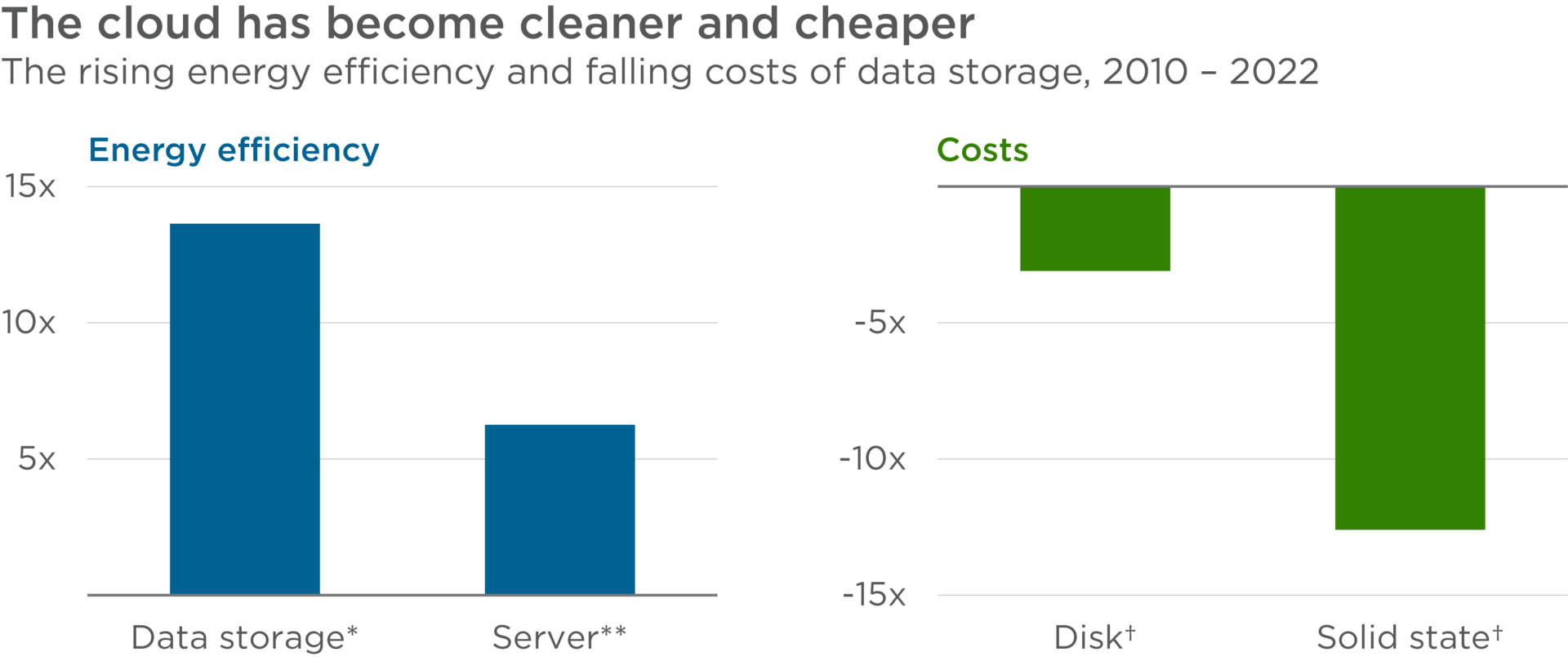
This bar chart contrasts the rising energy efficiency of data storage since 2010 and its falling costs. It’s broken down into four categories.
Category one: Data storage energy efficiency
Category two: Server energy efficiency
Category three: Disk storage costs
Category four: Solid state storage costs
The energy efficiency of data storage is estimated to be 13.6 times greater in 2022 than in 2010. The cost of solid state storage is estimated to be 12.6 times lower, per terabyte of data, in 2022 than in 2010.
Values
Numerical values presented on the image:
Change, 2022 vs 2010
| wdt_ID | Data storage energy efficiency | Server energy efficiency | Disk storage costs | Solid state storage costs |
|---|---|---|---|---|
| 1 | 13.6x | 6.3x | -3.1x | -12.6x |
Presentation
The bar chart represents the change in energy efficiency, for data storage and servers, and the change in cost, by data storage technology, over this period.
* Data storage energy efficiency data is based on average storage drive energy use (kilowatt-hour per terabyte of data). ** Server energy efficiency data is based on typical server energy intensity (watt-hour per computation). † Disk and solid state data storage costs are based on the cheapest historical price recorded.
Source: Impax analysis, 2023, based on (1) Energy efficiency data from Masanet, E., et al., 2020: Recalibrating global data center energy-use estimates, Science. Impax estimates for the period 2019 to 2022, extrapolated from 2010 to 2018 data; and (2) Energy storage cost data from McCallum, J.C., 2022 published in Our World in Data: Historical cost of computer memory and storage.
Data centres consume colossal amounts of energy. Powering and cooling their servers and other hardware used between 0.9% and 1.3% of global electricity in 2021.1 The upper estimate is roughly the same as the whole UK economy.
To focus on absolute numbers overlooks a more interesting story, though. Despite exponential growth in global data consumption and accumulated data, total electricity used by the world’s data centres has risen by barely 20% since 2010.2
Advances in energy efficiency have kept pace. Electricity use per terabyte of installed storage has fallen by more than 90% since 2010 as a result of storage-drive density and the efficiencies of larger ‘hyperscale’ data centres that now dominate the market.3 Several data centre operators are also major buyers of renewable energy, reducing their emissions further. The three largest cloud providers are among the world’s top four users of renewable energy power purchase agreements.4
Technological advances have meanwhile driven down data storage costs. The cost of high-performance solid-state drives – which, unlike disk drives, store data on electronic circuits – fell more than 12-fold between 2010 and 2022.5
The convenience and scalability of being able to store and access data remotely, as opposed to on premises, have made cloud storage a compelling proposition for more businesses and individuals.
Cloud-based services like data storage form a fast-growing pillar of modern digital infrastructure: spending on public cloud services is forecast to grow by 21% in 2023 to US$592bn.6 Continued adoption of the technology can lead to higher server utilisation rates and so deliver a virtuous cycle of further environmental and cost efficiencies.
1IEA, 2022: Data Centres and Data Transmission Networks. This figure excludes energy used for cryptocurrency mining.
2Masenet et al, 2020: Recalibrating global data center energy-use estimates. Science. In 2010, estimated global data centre energy consumption was 203 to 273 TWh. In 2021, the IEA estimated it to be 220 to 320 TWh.
3Masenet et al, 2020: Recalibrating global data center energy-use estimates. Science. Impax estimates for the period 2019 to 2022, extrapolated from 2010 to 2018 data.
4IEA, 2022: Data Centres and Data Transmission Networks. Amazon, Microsoft and Google were among the top four corporate offtakers of renewable energy power purchase agreements, by GW of electricity, between 2010 and 2021.
5McCallum, J.C., 2022 published in Our World in Data: Historical cost of computer memory and storage.
6Gartner, 2022: Gartner Forecasts Worldwide Public Cloud End-User Spending to Reach Nearly $600 Billion in 2023.
CFA® and Chartered Financial Analyst® are registered trademarks owned by CFA Institute
Nothing presented herein is intended to constitute investment advice and no investment decision should be made solely based on this information. Nothing presented should be construed as a recommendation to purchase or sell a particular type of security or follow any investment technique or strategy. Information presented herein reflects Impax Asset Management’s views at a particular time. Such views are subject to change at any point and Impax Asset Management shall not be obligated to provide any notice. Any forward-looking statements or forecasts are based on assumptions and actual results are expected to vary. While Impax Asset Management has used reasonable efforts to obtain information from reliable sources, we make no representations or warranties as to the accuracy, reliability or completeness of third-party information presented herein. No guarantee of investment performance is being provided and no inference to the contrary should be made.

 United States
United States